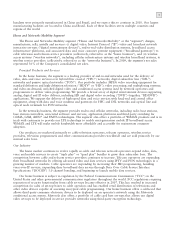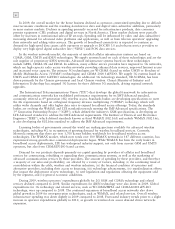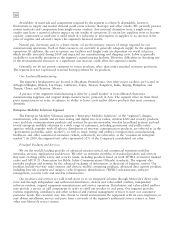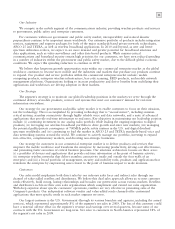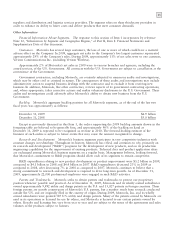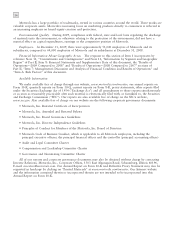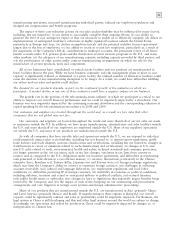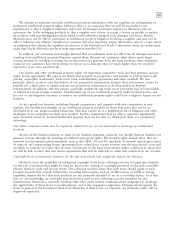Motorola 2009 Annual Report Download - page 23
Download and view the complete annual report
Please find page 23 of the 2009 Motorola annual report below. You can navigate through the pages in the report by either clicking on the pages listed below, or by using the keyword search tool below to find specific information within the annual report.
15
suppliers and distribution and logistics services providers. The segment relies on these third-party providers in
order to enhance its ability to lower costs and deliver products that meet consumer demands.
Other Information
Financial Information About Segments. The response to this section of Item 1 incorporates by reference
Note 12, ‘‘Information by Segment and Geographic Region,’’ of Part II, Item 8: Financial Statements and
Supplementary Data of this document.
Customers. Motorola has several large customers, the loss of one or more of which could have a material
adverse effect on the Company. In 2009, aggregate net sales to the Company’s five largest customers represented
approximately 29% of the Company’s sales. During 2009, approximately 11% of net sales were to one customer,
Verizon Communications Inc. (including Verizon Wireless).
Approximately 2% of Motorola’s net sales in 2009 were to various branches and agencies, including the
armed services, of the U.S. Government. All contracts with the U.S. Government are subject to cancellation at the
convenience of the Government.
Government contractors, including Motorola, are routinely subjected to numerous audits and investigations,
which may be either civil or criminal in nature. The consequences of these audits and investigations may include
administrative action to suspend business dealings with the contractor and to exclude it from receiving new
business. In addition, Motorola, like other contractors, reviews aspects of its government contracting operations,
and, where appropriate, takes corrective actions and makes voluntary disclosures to the U.S. Government. These
audits and investigations could adversely affect Motorola’s ability to obtain new business from the U.S.
Government.
Backlog. Motorola’s aggregate backlog position for all Motorola segments, as of the end of the last two
fiscal years was approximately as follows:
December 31, 2009 $4.9 billion
December 31, 2008 $5.0 billion
Except as previously discussed in this Item 1, the orders supporting the 2009 backlog amounts shown in the
foregoing table are believed to be generally firm, and approximately 90% of the backlog on hand at
December 31, 2009 is expected to be recognized as revenue in 2010. The forward-looking estimate of the
firmness of such orders is subject to future events that may cause the amount recognized to change.
Research and Development. Motorola’s business segments participate in very competitive industries with
constant changes in technology. Throughout its history, Motorola has relied, and continues to rely, primarily on
its research and development (‘‘R&D’’) programs for the development of new products, and on its production
engineering capabilities for the improvement of existing products. Technical data and product application ideas
are exchanged among Motorola’s business segments on a regular basis. Management believes, looking forward,
that Motorola’s commitment to R&D programs should allow each of its segments to remain competitive.
R&D expenditures relating to new product development or product improvement were $3.2 billion in 2009,
compared to $4.1 billion in 2008 and $4.4 billion in 2007. R&D expenditures decreased 23% in 2009 as
compared to 2008, after decreasing 7% in 2008 as compared to 2007. Motorola continues to believe that a
strong commitment to research and development is required to drive long-term growth. As of December 31,
2009, approximately 22,000 professional employees were engaged in such R&D activities.
Patents and Trademarks. Motorola seeks to obtain patents and trademarks to protect our proprietary
position whenever possible and practical. As of December 31, 2009, Motorola and its wholly owned subsidiaries
owned approximately 9,992 utility and design patents in the U.S. and 13,027 patents in foreign countries. These
foreign patents are mostly counterparts of Motorola’s U.S. patents, but a number result from research conducted
outside the U.S. and are originally filed in the country of origin. During 2009, Motorola, Inc. and its wholly
owned subsidiaries were granted 587 U.S. utility and design patents. Many of the patents owned by Motorola are
used in its operations or licensed for use by others, and Motorola is licensed to use certain patents owned by
others. Royalty and licensing fees vary from year to year and are subject to the terms of the agreements and sales
volumes of the products subject to licenses.


